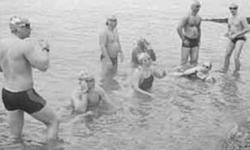Training
Every swimmer will develop his or her own training programme. This will be based on previous experience, coaching ideas, conversations with other swimmers and/or facilities available. There are, however, some aspects that will apply to everyone. To swim the Channel, you must consider the following factors:
Train safe. Above all else, please train safely, particularly in the sea. Carry out your own risk assessment, check tides and currents, swim in company, let someone responsible know what you're planning and, if swimming away from the shore, obtain appropriate boat and crew-support.
Water temperature. This is between 59°F and 64.5°F (15°C to 18°C). The temperature is around 59°F to 60°F at the end of June beginning of July, then rises slowly to 64/65°F by the end of August beginning of September, then it usually drops by a couple of degrees before the beginning of October. There are however exceptional years like 1995 when the water temperature reaches 67°F (19°C). Try to train in temperatures around 60°F (15.5°C). There is no need to train in water that is too cold (below 55°F/12°C ) and do not convince yourself that if you are swimming in 70°F/21°C then it is almost the same.
Bi-lateral breathing. Train yourself to breathe bi-laterally. This will mean that you can swim on either side of the escort boat using the shelter of the hull if the wind gets up or avoiding the exhaust fumes if the wind is in the wrong direction.
Air temperature and chill factor. This varies considerably depending on the weather and the hours of daylight. The longest day is around the 21st of June, giving daylight from about 0330 to 2200 hours. This decreases to 0600 to 1900 hours by the end of September. Body heat is lost from the parts of the swimmer exposed to the air (head and shoulders, etc.). The air temperature is higher during daylight hours, therefore the longer the day, the greater the period of higher air temperature, and the smaller the loss of body heat.
Hypothermia. The normal body temperature is 98.6°F (37°C). Hypothermia develops when the body temperature falls below about 95°F (35°C). Moderate hypothermia can usually be reversed, and a complete recovery made if it is recognised and treated quickly. However, if the body temperature falls below 75°F (24°C), recovery is unlikely. The symptoms and signs of the onset of hypothermia are difficult to recognise to the inexperienced eye. They are basically bouts of shivering, disorientation, irrational behaviour, blueness of the lips, inability to concentrate or co-ordinate speech, and inability to respond to simple requests or questions. If hypothermia arises your team must do as they are instructed - your life may depend on it!
Feeding. This needs a great deal of thought on behalf of the swimmer and his/her team. Keep the feeding time to a minimum. (For example 3 minute feeds every hour for the first 2 hours then 3 min feeds every 1/2 hour will add over an hour to a 12 hour swim). Arrange the feeding pattern well in advance. The most common pattern is hourly feeds for the first 2 hours then 1/2 hourly feeds for the remainder of the swim. Your feed time should be less than 1 minute a stop. Try the different types of feed to see which suits you. These days most swimmers use a high carb feed like Maxim. You must however get used to these feeds well in advance as they have a high input and it can take some time for your body to adapt. Make sure you get the quantities right as too much at a time can upset your system. Almost every swimmer will go through a bad patch around the 5th, 6th, or 7th hour when the body starts to convert its own fat to energy. Understand this problem and try to train through it. It's important for you to know this is going to happen.
Swim technique. Ask your coach, or someone with a professional eye, to analyse your stroke to ensure it is technically correct for swimming in the sea. The importance of outdoor training cannot be emphasised enough. The body reacts and performs differently in cold water. Do as many of your long swims as possible in open water. Pool swimmers and national champions have found that the transition to open water takes a lot of time and effort. You must start early to acclimatise to long periods in cold water. To obtain the maximum benefit from pool work, do not swim for long periods without a break. Far from building up your stamina, it will make you sluggish. Lots of interval work is far better. Try to get that extra centimetre out of every arm-pull. The more efficient your stroke, the better your chances of success.
Speed. Keep a regular check on your speed. Your pilot will want to know your swim rate and this must be a realistic timing, taken at the end of your training period. It is important for your pilot, you and your team to have a good idea of the time you will take to complete your crossing. Time yourself over a distance (1,000 yards or 1,000 metres) then you can calculate your approximate crossing time.
The shortest distance is 19 nautical miles from England to France.
1 nautical mile is approximately 2000 yards or 1852 metres.
19 nm x 2000 yd's is 38,000 yards to swim the Channel by the shortest route.
19 nm x 1852 mtrs is 35,200 metres to swim the Channel by the shortest route.
You can work out your approximate crossing time by simple mathematics once you have your average swim distance for an hour.
Yards Example: at 3,000 yards an hour you will take (38000 yards divided by 3000 yards) which is 12.7 hours. To this you need to add your feed time (12.7 hours x 4/5 min's feed per hour) giving a total of about 13.5 to 14 hours for the crossing.
Metres Example: at 3,000 metres an hour you will take (35200 metres divided by 3000 metres) which is 11.7 hours plus your feed time. To this you need to add your feed time (11.7 hours x 4/5 min's feed per hour) giving a total of about 12.5 hours. This shows how important it is to feed as quickly as possible.
Once you have an idea of your crossing time, you can start to prepare yourself mentally. Always remember that the Channel is a mental as well as a physical swim. Possibly even more mental than physical.
Mental attitude. Many a failure has come about by not having the right mental attitude. Willpower is needed to push through the pain barriers that never go away. A "split Channel swim" two or three weeks before your crossing is an ideal way to mentally and physically test yourself, i.e. do a 7 hour swim one day then a 6 hour swim the next, then you can taper down your training to just an hour or two on the days before you swim.
Grease. Any type of protective grease is permitted, what is normally used is usually a mixture of Lanolin and Petroleum Jelly, obtainable from Boots Chemists Limited, Folkestone and Dover. On returning to the pilot boat after the swim, swimmers are required to avoid fouling the boat and equipment with grease. You must provide a set of old clothes to cover the grease on your body as it is not easy to remove.
- 21 Jan 2025

2025 Notice of CS&PF AGM
Notice of CS&PF AGMFor the year ended 31st December 2024To be held atThe Channel Suite, Leas Cliff HallThe Leas, FolkestoneCT20 2DZ1pm on the 15th March 2025 Full members of the Channel Swimming and Piloting Federation are requested to note that any nominations for CS&PF officers and committee positions and/or notices of motions must be with the CS&PF secretary, in writing, at least 21 clear days before the AGM. This year that means the deadline is midnight on Friday 21st February 2025 CS&PF rules state:-The CS&PF Officers and Committee members, (excluding President and Vice President) to be elected by rotation with half (1/2) being elected every year over a 2 year period. CS&PF officer positions are to be elected from CS&PF members who are serving or have served on the CS&PF committee. Officer and committee positions due for election in 2025 President: Mike Ball (nominated by the CS&PF committee)Vice-President: Michael Oram (nominated by the CS&PF committee) The ChairmanThe SecretaryTwo Committee member positions All persons wishing to stand must be full CS&PF members (please include membership numbers). Nominations must be proposed and seconded by CS&PF Full Members (again, please include membership numbers). All nominations must be made within the rules available on the CS&PF web site www.cspf.co.uk (under the ‘about us’ heading). Notices of Motion Any motions put forward for inclusion in the AGM agenda must be submitted to the CS&PF secretary (email: secretary@cspf.co.uk or by post to 5, Charter House, Camden Crescent, Dover, CT16 1LE) with the names and signatures of the proposer and seconder. The proposer and seconder must be full CS&PF members (including membership numbers). Voting will be by paper ballot for any contested positions or motions. Read more
Sandettie Lightship Observations
7pm, 11th February 2025
Water: 45.9 °F (7.7 °C)
Air: 40.8 °F (4.9 °C)
Wind Speed: 9.9 kn (18.3 km/h)
Wind Direction: WNW (300°)
The CS&PF President, Mike Ball and all the committee are deeply saddened by the passing of Ady Brown.… https://t.co/E17pLxZwgw
2 years ago

